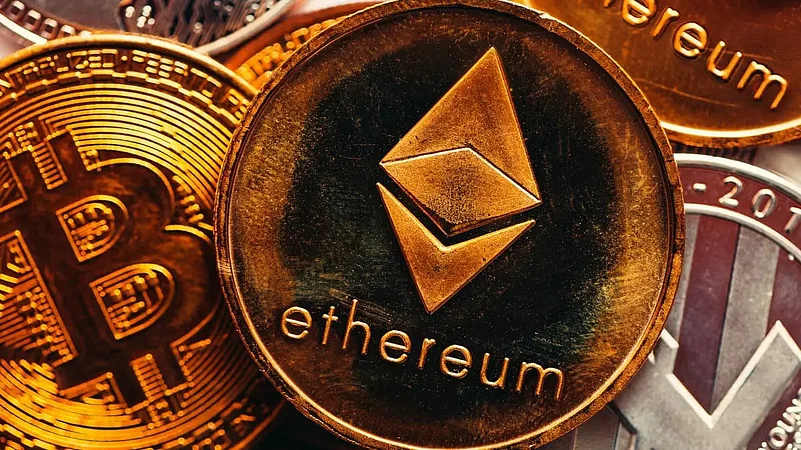In the ever-evolving world of cryptocurrency, Ethereum has been leading the way for years, opening up the possibilities of decentralised finances and Blockchain technology. It was launched in 2015 by Vitalik Buterin and a team of innovators, picked up popularity quickly, and became the foundation for a new generation of decentralised applications (dApps) and smart contracts. Its rapid expansion saw it peak in 2017 with a shocking 500 per cent boost, setting the stage for it to hit an all-time record of $4,891.70 in November 2021. Despite these achievements, Ethereum has not been able to hold its top spot in a market that is currently dominated by Bitcoin, with emerging rivals like Solana and XRP becoming increasingly popular.
Ethereum’s is currently trading at $2,406.73 as on February 25, 2025, with a 24-hour trading volume of $35.75 billion. The price is down 10.75 per cent over the last 24 hours, while Bitcoin trades at $89,465.19, which is down by 6.50 per cent within the past 24 hours. Its volume in the past 24 hours is 64.76 billion, Coinmarketcap.com reported.
Ethereum, previously a dominant force in the cryptocurrency world, is facing fresh competition.
According to a Coinswitch report titled India’s Crypto Portfolio 2024: How India Invests, Ethereum and Bitcoin continue to dominate investor preferences, developing Blockchain technologies and other cryptocurrencies are reshaping the market. PEPE Coin has drawn a lot of attention and many investors have been captivated by its impressive 1,373 per cent return. Significant progress has also been achieved by XRP. On November 30, 2024, it surpassed $100 billion in market capitalisation and jumped two ranks to take the seventh place. Also, meme currencies like Dogecoin have gained in popularity, with over 8 per cent of investors choosing them as their first choice. On the contrary, Ethereum remains a prominent participant, but the introduction of substitutes such as Solana and PEPE Coin shows that its market dominance is diminishing.
Challenges
Ethereum faces a number of challenges that prevent it from fulfilling its potential, even if it is at the forefront of the Blockchain sector.
One of the most long-standing problems is scalability. The network still has issues processing large numbers of transactions quickly, despite ongoing migration to Ethereum 2.0, which brings with it the proof of stake (PoS) consensus mechanism.
At present, Ethereum is able to support approximately 15-30 transactions per second which becomes inadequate as the network grows more popular. The scalability issue is even more serious with the growing use of Ethereum, making it difficult for the network to keep up with the ever-growing need for transactions.
High gas fees are still a major concern for Ethereum, since users have to incur those charges while processing transactions or for executing smart contracts on the network. Gas prices are determined by the amount of computational work needed to process transactions, with the gas limit (the amount of work needed) and gas price (the price per unit of work) controlling the overall fee. In heavy traffic periods, like non-fungible token (NFT) sales or busy dApps, gas prices skyrocket, reaching as high as $165 per transaction. This makes Ethereum expensive for small transactions and restricts its wider use.
Gas charges vary with congestion on the network, and increasing demand raises prices. Though Ethereum 2.0 is expected to resolve issues of scalability, high gas costs remain an entry barrier for many. Users may time their transaction during non-peak times via EtherScan’s gas tracker or use Layer 2 solutions. Layer 2 solutions execute transactions off-chain, taking less traffic off the Ethereum main network and keeping fees at a low cost.
With Ethereum still reeling from high gas costs and scalability problems, a fix has been proposed: Layer 2 solutions. These technologies operate on top of the existing Ethereum Blockchain to reduce congestion, reduce fees, and accelerate transaction speeds, without sacrificing decentralisation and security of the network. By executing off-chain or sidechain transactions, Layer 2 solutions take the load off the central network, saving fees and allowing more transactions to be executed in bulk. These solutions are critical to improving Blockchain performance without sacrificing its fundamental principles.
Some popular Layer 2 solutions include rollups, state channels, plasma, and sidechains. Rollups, the most common, handle transactions off-chain and occasionally sends data back to the main chain for security, with Optimistic and Zero-Knowledge versions. State channels reduce costs by allowing several off-chain transactions between parties and only records the final state on the main chain. The future scalability of Blockchain networks like Ethereum depends on these solutions, which are widely used in decentralised finance (DeFi), gaming, and NFTs.
Also, Blockchain systems, including Solana, Binance Smart Chain (BSC), and Cardano pose a serious competition to Ethereum. These alternatives provide faster transaction speeds and lower fees, attracting significant developer and user interest.
The transaction per second (TPS) of Ethereum is currently far slower than Solana’s, which can process up to 65,000 transactions per second. The transaction costs of Binance Smart Chain are frequently less than $1 as compared to Ethereum’s increased gas prices during network congestion. Ethereum’s position as the industry leader in Blockchain technology is now coming under growing assault, as alternative platforms continue to provide more effective and affordable solutions.
Also, the energy usage of Ethereum, which is fuelled by its present proof of work consensus process, is still a contentious issue. The high energy usage of proof of work has drawn criticism. Although Ethereum is transitioning to PoS with Ethereum 2.0, which is expected to reduce its environmental impact by up to 99 per cent, the legacy of proof of work continues to attract concerns. Ethereum’s energy usage continues to be a major source of dispute until the full advantages of this change is realised.
As Ethereum faces increasing competition and challenges, experts believe that Ethereum can adapt to changes to stay competitive.
Says Vedang Vatsa, founder of Hashtag Web3: “To stay competitive, Ethereum should focus on scalability, reduce transaction costs, and enhance user experience. While Layer-2 solutions improve efficiency, they shift activity away from the main network. Additionally, the approval of spot Bitcoin exchange-traded funds (ETFs) has drawn investor attention, potentially diverting capital from Ethereum, while rising competition from PoS Blockchains challenge its dominance in the smart contracts and DeFi space.”
The Underlying Potential Of Ethereum
In the Blockchain sector, Ethereum has consistently shown its vast potential, and its strengths are obvious from its continued leadership in important areas. One of its most significant achievements is the development of smart contracts and their role in DeFi.
Ethereum has allowed dApps that don’t need intermediaries by utilising smart contracts. This development has prepared the way for a wide range of financial services, such as lending, borrowing, and trading, to be carried out in a transparent and accessible manner around the world.
The transition to Ethereum 2.0, powered by the PoS consensus mechanism is another significant step toward addressing scalability and energy consumption challenges. The Ethereum 2.0 upgrade is designed to increase the Blockchain’s transaction throughput, with an ambitious target of processing up to 100,000 TPS through Layer-2 scaling solutions. By lowering transaction costs and network congestion, Ethereum will continue to be a scalable and effective platform despite its user base and transaction volume increase.
Ethereum’s dominance in the NFT space further highlights its robust infrastructure and versatility. Ethereum is the top Blockchain for NFTs and facilitates a substantial chunk of the market for digital assets, which encourages the expansion of tokenised assets, such as digital art and collectibles.
Ethereum has also established itself as a platform of choice for enterprise-level applications by drawing in large corporations searching for Blockchain solutions in a variety of sectors, such as supply chain management and finance.
One of Ethereum’s most valuable assets is its thriving developer community, which remains one of the largest and most active in the Blockchain ecosystem. By fostering innovations like Layer-2 scaling solutions and next-generation dApps, this active community is constantly expanding the possibilities of Ethereum. It is in a strong position to maintain its position as a leader in the quickly developing field of Blockchain technology.
Ethereum ETFs: A Growing Market For Crypto Investment
The Ethereum ETF market has seen strong growth, as more institutional and individual investors look for regulated exposure to Ethereum without actually owning the cryptocurrency. Investors can buy Ethereum on conventional stock markets just like any other asset by investing in an Ethereum ETF, as the ETF follows the price of Ethereum. They are divided into two broad groups, which are futures ETFs and spot ETFs. Futures ETFs invest in Ethereum futures contracts, enabling speculators to wager on the price of Ethereum in the future. However, spot Ethereum ETFs directly hold Ethereum, giving investors immediate exposure to the present market value.
As of February 24, 2025, the Ethereum ETF market has seen a decrease in assets under management (AUM), now standing at $10 billion. This is accompanied by an outflow of $29.80 million, reflecting the ongoing demand and shifts in the cryptocurrency investment landscape. Among the most well-known Ethereum ETFs on the market are the iShares Ethereum Trust ETF (ETHA) and Fidelity Ethereum Fund (FETH) in the spot category, and the ProShares Ether ETF (AETH) and VanEck Ethereum Strategy ETF (EETH) in the futures options. ETFs provide a useful and regulated means of investing in cryptocurrencies, and this indicates that Ethereum is becoming more popular.
Bitcoin ETFs are also having a significant influence on the cryptocurrency investing sector, along with Ethereum. As on February 24, 2025, Bitcoin ETFs have amassed $114 billion in AUM, despite a net outflow of $347.80 million. The approval of spot Bitcoin ETFs in January 2024 has provided direct exposure to Bitcoin’s price enhancing transparency and investment efficiency. Similarly, Ethereum’s spot ETFs were approved in May 2024, further solidifying the cryptocurrency market’s growth. The approval of both Bitcoin and Ethereum spot ETFs marks an important development in the crypto investment market, attracting broader institutional participation and elevating the standing of both assets. While Bitcoin and Ethereum are the only cryptocurrencies with approved spot ETFs, other digital assets like Solana, Litecoin, and Cardano may also come up with similar offerings in the future.
Ethereum’s Future
When considering Ethereum’s future possibilities, a number of factors come into action that might influence its course.
Edul Patel, co-founder and CEO of Mudrex, shares his insights. “Ethereum has gained over 45 per cent in 2024, reaching a high of $4,100 during the bull run. While ETH did not see much price momentum, it has immense potential to reclaim its highs, driven by increasing adoption of Layer 2 solutions like Base and Starknet. Ethereum’s ability to innovate through Ethereum 2.0 and maintain scalability and efficiency will impact its price in the coming months,” he says.
He further emphasises the importance of diversification in investors’ portfolios.
“Ethereum ETF inflows are also gaining momentum, as it closed the year 2024 with over $12.11 billion in AUM, showing healthy confidence from institutional investors, as well. While having exposure to ETH, it is important that investors diversify their portfolios with other stable assets like Bitcoin, Solana, and others for better risk-adjusted returns.”

















